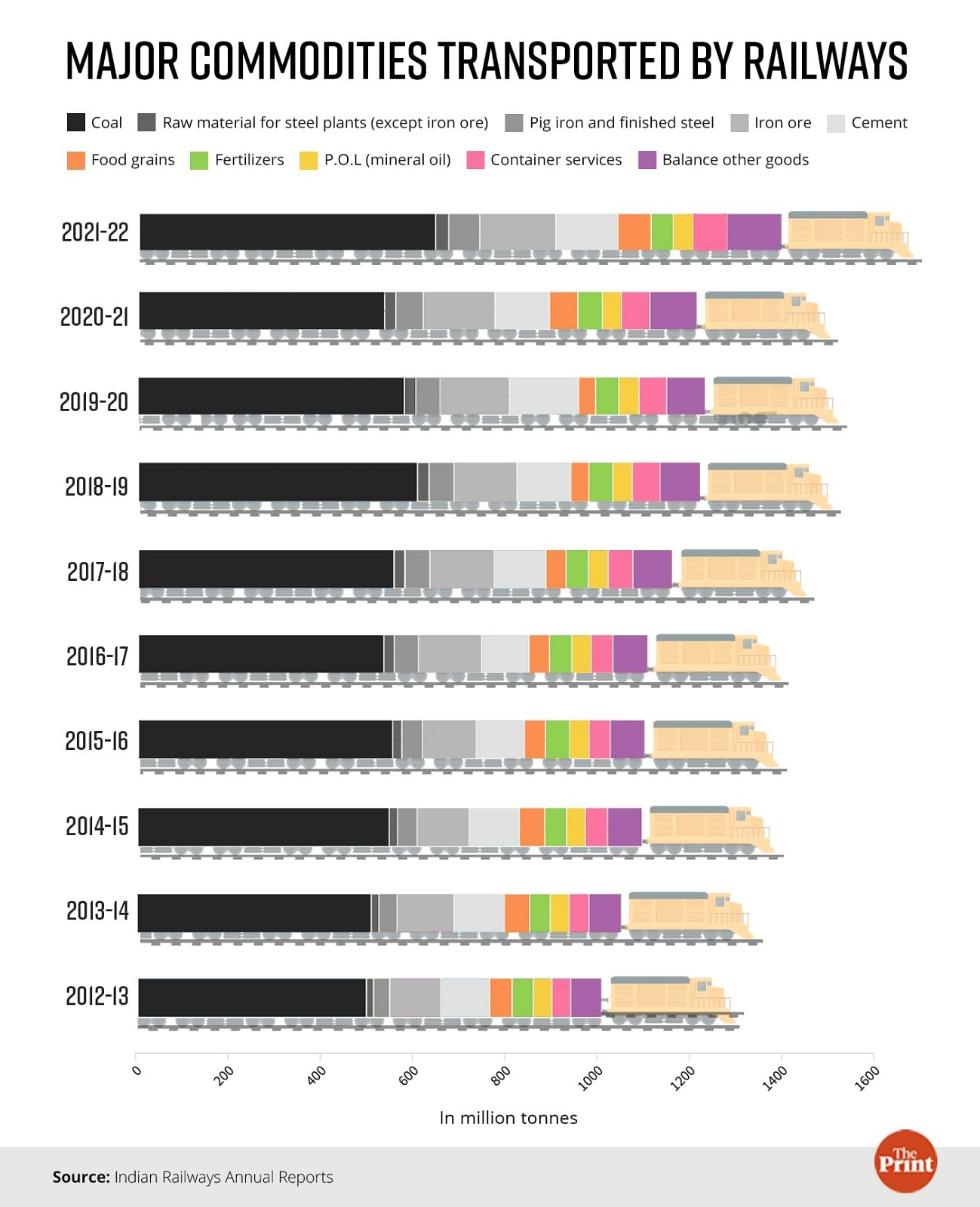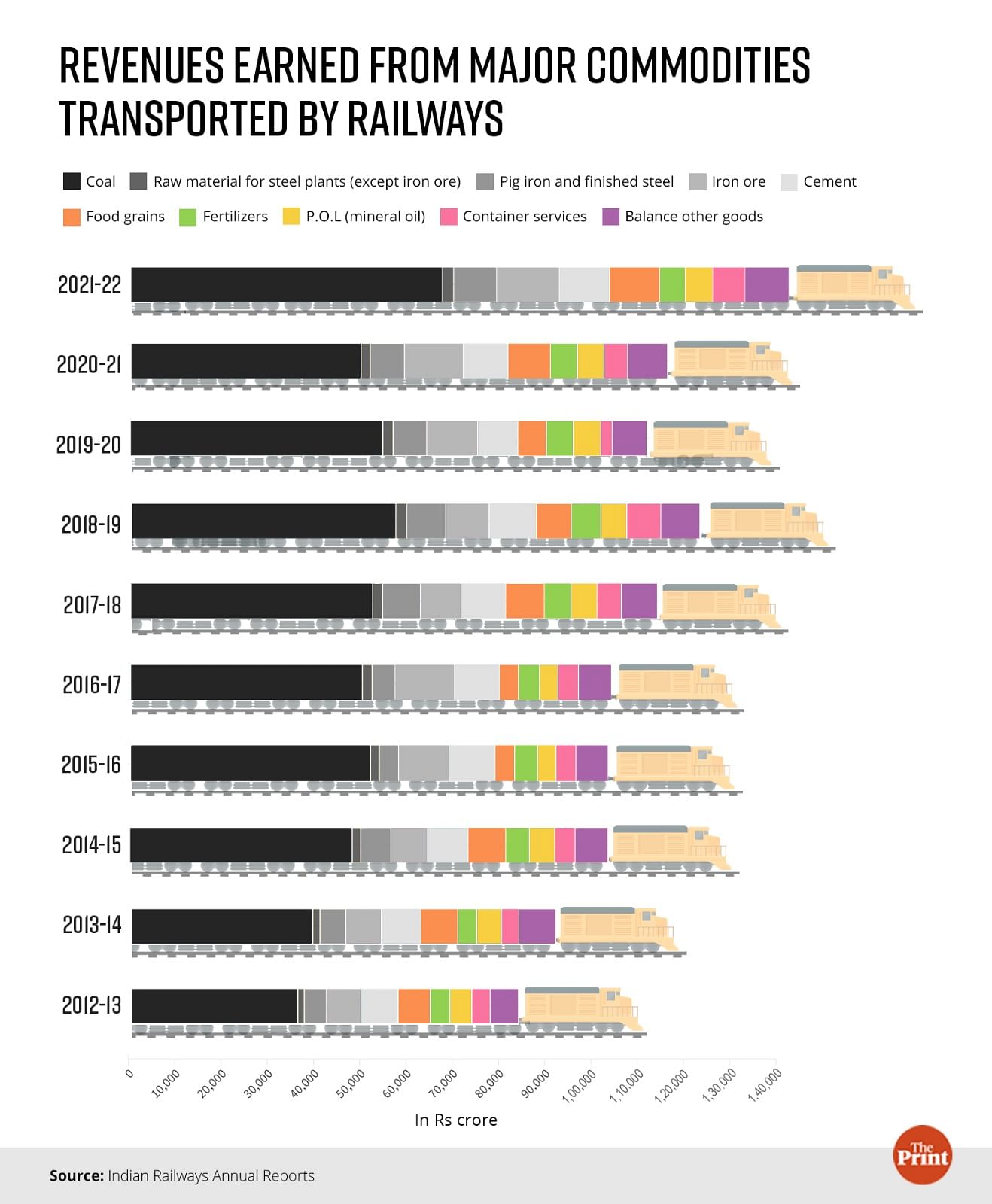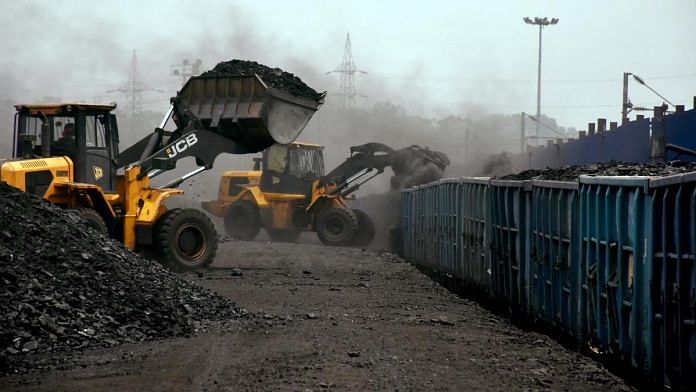New Delhi: The Indian Railways, which has been pushing for greater revenue from its freight services, registered record earnings from the segment in the last financial year (2022-23) — about Rs 1.62 lakh crore.
But the bulk of these revenues come from coal, a fossil fuel, which raises questions about its sustainability as a source of income as India pursues action to combat climate change.
India is working towards achieving net zero emissions — reducing emissions as much as possible, while making arrangements for any residual emissions to be absorbed from the atmosphere — by 2070.
This would require reducing the country’s overall dependency on coal and moving to renewable sources of energy.
In the 10-year period from 2012-13 to 2021-22, the contribution of coal to railways’ revenues increased to just over 47 percent, from 43 percent. In absolute terms, of the total freight revenue of Rs 1.39 lakh crore in 2021-22, Rs 65,856.08 crore was from coal transportation.
Other major contributors to railways’ freight revenue — the transporter’s major source of income — are ‘bulk items’ such as iron and steel, iron ore, foodgrains, cement, petroleum products and fertilizers.

Bulk goods are those that are not containerised and are directly moved through a vessel in large quantities as opposed to non-bulk goods, which are often packaged.
Railways’ data shows that coal is the only major commodity whose contribution to freight revenue has shown significant growth.
Raw material for steel products accounted for 1.7 percent of freight revenues in 2021-22, against 1.65 percent in 2011-12. Container services saw a slight increase in revenue contribution, to 4.9 percent from 4.79 percent. The contribution of cement fell in this period to 7.6 percent, from 9.5 percent. Foodgrains (share in revenue down to 7.6 percent from 8.35 percent), fertilizers (3.9 percent from 5 percent) and mineral oil (4 percent from 5.6 percent) showed a similar trend.
The railways has been trying to increase the revenues from other products, which largely include non-bulk goods such as consumer durables and automobiles. These contributed around 6.6 percent to freight revenues in 2021-22, slightly lower than 7 percent in 2012-13.
In 2022-23, the railways’ gross revenue stood at about Rs 2.4 lakh crore, of which Rs 1.62 lakh crore came from freight services, and Rs 63,300 crore from the passenger segment.
In a report on railway finances for the financial year ending March 2021, the Comptroller and Auditor General (CAG) pointed out that the transporter depends heavily on coal for its freight services. “Any shift in the bulk commodities transport pattern could affect the railways’ freight earnings significantly,” it said. “Railways have not been able to diversify their freight basket despite running various incentive schemes for a long time.”

ThePrint reached the railways spokesperson through call and text for a comment on potential plans to diversify the transporter’s freight portfolio, but no response was received by the time of publishing this report.
Experts say that despite the growing thrust on clean energy, coal will continue to remain a key cargo commodity not only for railways, but the overall logistics sector.
Also Read: Safety in focus but what’s Railways spending money on? More on new projects, less on upkeep
Coal and the railways
Speaking to ThePrint, Jagannarayan Padmanabhan, senior director, CRISIL Market Intelligence and Analytics, said “freight revenue is a major contributor to the overall revenue of Indian Railways”.
“Freight business over the years has cross-subsidised the passenger business segment. Hence, for maintaining a healthy operating ratio, it is imperative that the revenues from this segment do not dip,” he added.
Suprio Banerjee, vice-president & sector head — corporate ratings, ICRA Limited, noted that coal “is a key raw material in India for various industries”.
“A large part of coal is imported, and domestic coal mining is concentrated in a few locations. However, it is distributed to many parts of the country. Hence, the transportation of coal forms a dominant share in goods transferred and remains a critical cargo for railways,” he added.
“Although, the growing thrust on other forms of clean fuel, like renewable energy, will be at the forefront of capacity additions in the power sector. Given the large dependence on thermal as a fuel for power generation in India, as well as usage of coal for other industries like steel, cement, etc., coal will continue to be a key cargo for the overall logistics sector, not only railways.”
A former railway officer told ThePrint that the railways has always been dependent on coal for freight revenues.
While the railways needs to diversify and increase the share of revenue from more commodities, “dependence on coal is unlikely to come down as the country still relies on thermal power to cater to increasing power demand and this is not expected to change soon”.
However, Padmanabhan said that, over the next decade, “as the sustainability agenda takes further centrestage and there is a move towards cleaner sources of power generation, it will have a significant impact on the freight business of the railways”.
“There is also a significant inertia factor for change of mode of transport among other commodities and hence it is important that the necessary ecosystem… is provided for making the change.”
According to data compiled by the government, in 2018-19, a total freight movement of 4,523.2 million tonnes occurred across the country.
Of this, 1,221.5 million tonnes — or about 27 percent — was moved by rail. The majority — 2,911.7 million tonnes or 64 percent — was transported by road. Other sources of transportation include coastal shipping (5 percent), inland waterways (2 percent) and pipeline (2 percent).
The railways has prepared a ‘National Rail Plan (NRP) for India – 2030’, which has set a target of increasing the modal share of the railways in freight to 45 percent by 2050.
Potential for expansion
A 2021 report by NITI Aayog and RMI India, on ‘Fast Tracking Freight in India — A roadmap for clean and cost-effective goods transport’, noted that the composition of India’s freight is 70 percent bulk and 30 percent non-bulk.
Of the bulk, 40 percent is still carried by trucks (or road). The railways has lost to roads in the logistics sector largely due to insufficient capacity, especially on certain high-density routes.
“While there is immense potential to move bulk freight from road to rail, low to medium value non-bulk products can also be moved by rail using intermodal transport,” the report noted.
It also pointed out that in the US — which offers a reasonable geographic comparison to India — 66 percent of non-bulk freight moves on road, with 30 percent being moved by rail or rail-intermodal. This is significantly lower than the 92 percent of non-bulk goods moved by trucks in India.
Padmanabhan noted that other modes of transport, especially roads, are able to provide significant flexibility to the transporters as well as offer end-to-end service and on-demand service.
For railways to grow as a freight service, he said, it is important they provide necessary wagons on demand and also have time-table-based service.
Banerjee added, “In the railway mode of transportation, as the same line caters to passengers as well as freight, preference is given to passenger rails compared to freight locos, which adds up to the issue of timely goods transportation.
“Further, some routes on networks have been running at capacities greater than 100 percent, which has been straining and slowing down the network.”
Once the dedicated freight corridor (DFC) is fully operational, he added, it is expected to be a game-changer in the Indian logistics industry.
“The setting up of a DFC would enable de-congestion of the saturated rail and road network and encourage the shifting of freight traffic from the existing road and rail networks to the more efficient DFC,” he said, adding that this would also free up capacities on the existing rail network, enabling it to cater to passenger trains largely, along with freight demand of additional commodities.
(Edited by Sunanda Ranjan)
Also Read: Vande Bharat Express is changing Indian Railways. Now Indians need to do their bit



